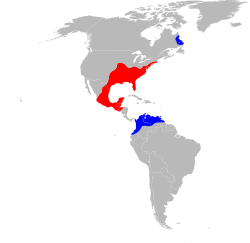Amblyomma americanum
| Den här artikeln har skapats av Lsjbot, ett program (en robot) för automatisk redigering. (2013-02) Artikeln kan innehålla fakta- eller språkfel, eller ett märkligt urval av fakta, källor eller bilder. Mallen kan avlägsnas efter en kontroll av innehållet (vidare information) |
| Amblyomma americanum | |
 | |
| Systematik | |
|---|---|
| Domän | Eukaryoter Eukaryota |
| Rike | Djur Animalia |
| Stam | Leddjur Arthropoda |
| Klass | Spindeldjur Arachnida |
| Underklass | Kvalster Acari |
| Ordning | Fästingar Ixodida |
| Familj | Hårda fästingar Ixodidae |
| Släkte | Amblyomma |
| Art | Amblyomma americanum |
| Vetenskapligt namn | |
| § Amblyomma americanum | |
| Auktor | Linnaeus, 1758 |
| Utbredning | |
 Rött är normalt utbredningsområde, blått är tillfälliga observationer | |
| Synonymer | |
| Amblyomma (amblyomma) americanum Camicas et al., 1998[1] Amblyomma (anastosiella) americanum Santos Dias, 1993[1] Ixodes orbicularis Neumann, 1901[1] Ixodes unipuncta Lewis, 1899[1] Amblyomma unipunctatum Thurow, 1891[1] Amblyomma foreli Stoll, 1890[1] Ixodes nigra Cobbold, 1879[1] Ixodes unipictus Verrill, 1870[1] Amblyomma unipunctum Packard, 1870[1] Ixodes unipunctata Packard, 1869[1] Euthesius americanus Gistel, 1848[1] Ixodes orbiculatus Say, 1821[1] Ixodes americanus Fabricius, 1805[1] Ixodes nigua Latreille, 1804[1] Rhynchoprion americanum Hermann, 1804[1] Acarus nigua De Geer, 1778[1] Acarus americanus Linnaeus, 1758[1] | |
| Hitta fler artiklar om djur med | |
Amblyomma americanum[2] är en fästingart som beskrevs av Carl von Linné 1758. Amblyomma americanum ingår i släktet Amblyomma och familjen hårda fästingar.[3][4] Inga underarter finns listade i Catalogue of Life.[3] Bett av fästingen har observerats orsaka allergi mot rött kött.[5]
Bildgalleri
- Utbredning.
Källor
- ^ [a b c d e f g h i j k l m n o p q] Camicas,J.-L., Hervy, J.-P., Adam, F. & Morel, P.C (1998) The Ticks of the World (Acarida, Ixodida). Nomenclature, Described stages, Hosts, Distribution, The Ticks of the World (Acarida, Ixodida). Nomenclature, Described stages, Hosts, Distribution.
- ^ Horak IG, Camicas J-L, Keirans JE (2002) The Ixodidae, Amblyommidae and Nuttalliellidae (Acari: Ixodida): a world list of valid tick names, Experimental and Applied Acarology, 28: 27-54.
- ^ [a b] Bisby F.A., Roskov Y.R., Orrell T.M., Nicolson D., Paglinawan L.E., Bailly N., Kirk P.M., Bourgoin T., Baillargeon G., Ouvrard D. (red.) (1 augusti 2011). ”Species 2000 & ITIS Catalogue of Life: 2011 Annual Checklist.”. Species 2000: Reading, UK. http://www.catalogueoflife.org/annual-checklist/2011/search/all/key/amblyomma+americanum/match/1. Läst 24 september 2012.
- ^ TicksBase. Nijhof A.M., Guglielmone A.A. & Horak I.G., 2005-06-15
- ^ ”Red meat allergies likely result of lone star tick” (på engelska). Science Daily. 20 februari 2014. http://www.sciencedaily.com/releases/2014/02/140220102727.htm. Läst 11 augusti 2014.
Externa länkar
 Wikimedia Commons har media som rör Amblyomma americanum.
Wikimedia Commons har media som rör Amblyomma americanum. Wikispecies har information om Amblyomma americanum.
Wikispecies har information om Amblyomma americanum.
Media som används på denna webbplats
Robot icon
This photograph depicts a dorsal view of a female “lone star tick”, Amblyomma americanum. An ixodid or “hard” tick, A. americanum is found through the eastern and south-central states and can transmit disease agents that affect humans, dogs, goats, and white-tailed deer. Representatives from all three of its life stages aggressively bite people in the southern U.S. Lone star ticks transmit Ehrlichia chaffeensis and Ehrlichia ewingii, both of which cause disease. Borrelia lonestari, a pathogen associated with “Southern tick-associated associated rash illness” (STARI), also infects lone star ticks. Research suggests that up to 10% of the lone star ticks in an endemic area can be infected with any one of these pathogens. These ticks also are infected with a spotted-fever group Rickettsia, “Rickettsia amblyommii” but it is unknown at this time if this bacterium causes disease. The obvious white dot, or “lone star”, identified this as an adult female of the species. The reduced scutal size enables the abdomen to expand to enormous proportions when ingesting a blood meal the tick extracts from its host food source, as seen in PHIL# 8677. In the male, the scutum covers almost the entire dorsal abdomen. Also, note the four pairs of jointed legs, placing ticks in the Phylum Arthropoda, and the Class Arachnida. To view additional images related to this tick specie, see PHIL 4407, and 8677 through 8685, and 9535.
This image depicts a dorsal view of a female lone star tick, Amblyomma americanum, and is found in the Southeastern, and Mid-Atlantic United States. Females exhibit the star-like spot on their distal scutum. This tick is a vector of several zoonotic diseases, including human monocytic ehrlichiosis, and Rocky Mountain spotted fever (RMSF). To view additional images related to this tick species, see PHIL 8676 through 8685, and 9535.
Map of the range of the Lone Star Tick (Amblyomma americanum). Red indicates where the species is normally found; Blue indicates other locations where the species has been reported.
The distribution of the Lone star tick ((Amblyomma americanum))
Development of the Lone star tick (Amblyomma americanum)







